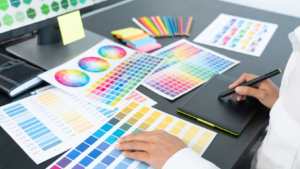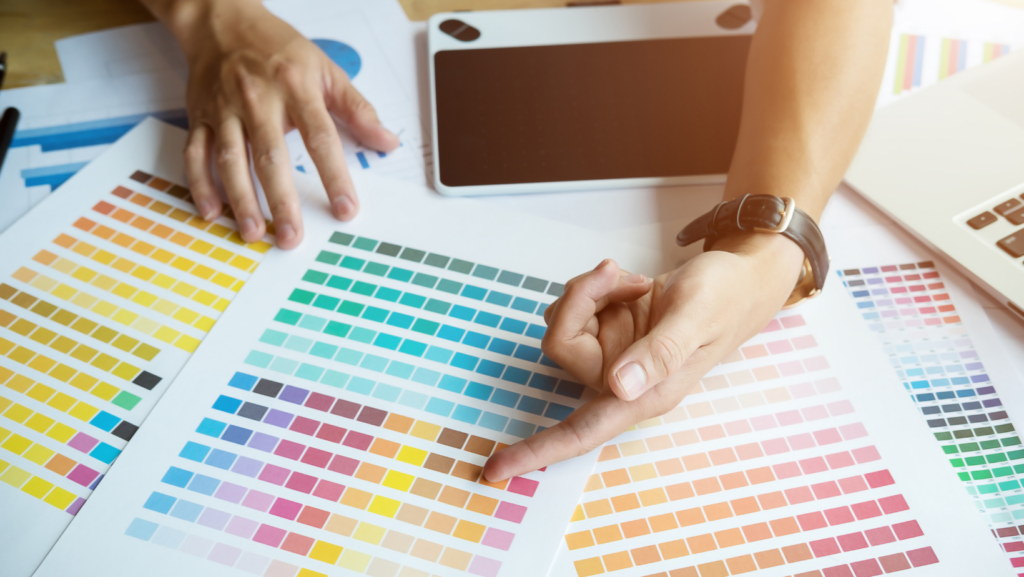While both graphic design and digital design might sound like two peas in a creative pod they’re actually quite different beasts. Think of graphic design as the cool artistic uncle who’s been around since the print era while digital design is the tech-savvy cousin who lives and breathes in the digital world.
In today’s evolving creative landscape these two disciplines often overlap creating confusion for aspiring designers businesses and clients alike. Understanding the key differences between graphic design and digital design isn’t just about splitting hairs – it’s essential for choosing the right career path hiring the right professional or selecting the perfect course of study. Let’s dive into what sets these two creative fields apart and discover which one might be the perfect fit for your needs.
Graphic Design VS Digital Design
 Graphic design and digital design represent distinct creative disciplines with specialized tools methodologies and applications. These two fields share some common principles yet differ significantly in their execution approach delivery methods.
Graphic design and digital design represent distinct creative disciplines with specialized tools methodologies and applications. These two fields share some common principles yet differ significantly in their execution approach delivery methods.
Graphic design focuses on creating visual content for print media electronic displays stationary packaging. Designers use Adobe Creative Suite tools like Illustrator InDesign Photoshop to manipulate typography images layouts. The field emphasizes fundamental design principles including color theory composition hierarchy balance white space. Projects typically include logos brochures business cards posters print advertisements magazines. Graphic designers work with specific color formats (CMYK) resolution requirements paper stocks printing specifications. The discipline requires knowledge of pre-press production processes bleeds crop marks color separations.
Core Elements of Digital Design
Digital design centers on creating interactive user interfaces websites mobile applications software platforms. The discipline incorporates user experience principles responsive layouts interactive elements dynamic content. Digital designers utilize prototyping tools like Figma Sketch XD alongside coding languages HTML CSS JavaScript. Projects focus on screen-based deliverables including website interfaces mobile apps digital advertisements social media graphics. The field demands understanding of user behavior analytics accessibility standards cross-platform compatibility. Digital designers consider factors like screen resolution device specifications loading times interactive states user flows.
Main Differences Between Both Design Fields
Graphic design and digital design utilize distinct tools methodologies to achieve their creative objectives. These differences extend from the software applications to the final deliverables produced in each field.
Tools and Software Used
Graphic designers primarily work with Adobe Creative Suite applications including Photoshop InDesign Illustrator. These tools focus on creating static visual elements through vector graphics raster image editing page layout capabilities. Traditional graphic design tools incorporate features for print production color management systems prepress workflow integration.
Digital designers employ specialized UX/UI software like Figma Sketch XD Webflow. These platforms enable interactive prototyping responsive design development user flow mapping. Additional tools include:
- Code editors (Visual Studio Code Sublime Text)
- Web development frameworks (React Angular)
- Version control systems (Git GitHub)
- Prototyping tools (InVision Principle)
Project Deliverables
Graphic design outputs center on print materials physical assets:
- Brand identity packages (logos business cards letterheads)
- Marketing collateral (brochures flyers posters)
- Packaging design (product boxes labels tags)
- Print publications (magazines books catalogs)
- Website user interfaces
- Mobile app designs
- Interactive prototypes
- Digital marketing assets (banner ads social media graphics)
- User experience documentation (wireframes user flows)
- Responsive layouts (desktop tablet mobile versions)
Career Paths and Job Opportunities
The graphic design and digital design fields offer diverse career opportunities across multiple industries. Each discipline presents unique paths for professional growth based on specialized skills and industry demands.
Graphic Design Roles
 Graphic designers find employment opportunities in advertising agencies, publishing houses, corporate marketing departments and independent studios. Art directors lead creative teams in developing brand identities, print campaigns and marketing collateral. Publication designers create layouts for magazines, books and newspapers using advanced typography skills. Package designers craft product packaging for retail brands, combining aesthetics with functional requirements. Brand identity specialists focus on logo design, style guides and visual communication systems. In-house designers work directly with organizations to maintain consistent visual messaging across all materials.
Graphic designers find employment opportunities in advertising agencies, publishing houses, corporate marketing departments and independent studios. Art directors lead creative teams in developing brand identities, print campaigns and marketing collateral. Publication designers create layouts for magazines, books and newspapers using advanced typography skills. Package designers craft product packaging for retail brands, combining aesthetics with functional requirements. Brand identity specialists focus on logo design, style guides and visual communication systems. In-house designers work directly with organizations to maintain consistent visual messaging across all materials.
Digital designers occupy roles in tech companies, web development firms and digital marketing agencies. UX designers research user behavior, create wireframes and develop interactive prototypes for digital products. UI designers craft intuitive interfaces for websites, mobile apps and software applications. Motion designers create animated graphics and transitions for digital platforms. Digital product designers oversee the entire design process from concept to implementation. Interactive designers develop engaging user experiences through responsive layouts and dynamic content. Front-end designers collaborate with developers to ensure seamless implementation of design systems.
Skills Required for Success
Success in design requires distinct skill sets tailored to each discipline’s unique demands. Professional designers develop expertise in specific areas based on their chosen career path.
Essential Graphic Design Skills
Graphic designers master visual composition through proficiency in typography selection color theory balance proportion. Technical expertise extends to Adobe Creative Suite including Photoshop InDesign Illustrator. Print production knowledge encompasses color modes CMYK output resolution prepress requirements file preparation. Advanced skills include:
- Creating vector illustrations using pen tools bezier curves shape manipulation
- Managing brand identity systems through style guides color palettes typography hierarchies
- Executing print layout designs with grid systems margins bleeds crop marks
- Developing package designs considering material specifications structural requirements production methods
- Crafting visual storytelling through image selection composition hierarchy
- Implementing responsive design systems using breakpoints fluid grids flexible images
- Creating interactive prototypes demonstrating user flows animations transitions
- Applying accessibility standards including WCAG guidelines color contrast ratios
- Understanding basic web technologies HTML CSS JavaScript frameworks
- Conducting user research through interviews usability testing data analysis
- Developing information architecture through site maps user flows wireframes
- Optimizing designs for multiple devices screen sizes operating systems
Industry Trends and Future Outlook
Digital design experiences rapid growth with a 13% increase in job opportunities from 2020 to 2023, outpacing traditional graphic design positions at 3% growth.
| Design Sector | Growth Rate (2020-2023) | Average Salary (2023) |
|---|---|---|
| Digital Design | 13% | $85,000 |
| Graphic Design | 3% | $56,000 |
Artificial Intelligence integration transforms both fields through automated design systems, template generation platforms, and AI-powered design tools like Midjourney and DALL-E.
Motion design emerges as a critical skill bridging graphic and digital design, with 76% of businesses incorporating motion graphics in their marketing strategies.
Cross-disciplinary expertise gains importance as companies seek designers proficient in:
- Augmented Reality (AR) interface design
- Voice User Interface (VUI) development
- 3D modeling and visualization
- Sustainable design practices
Remote collaboration tools reshape design workflows through:
- Cloud-based design platforms
- Real-time collaboration features
- Version control systems
- Virtual whiteboarding solutions
Emerging technologies create specialized design roles focusing on:
- Extended Reality (XR) experiences
- Blockchain interface design
- Responsive design for foldable devices
- Gesture-based interface development
The metaverse expansion drives demand for designers skilled in:
- Virtual environment design
- Avatar customization systems
- Digital asset creation
- Immersive experience development
Data visualization becomes increasingly important with 85% of businesses prioritizing interactive dashboards and infographic design in their communication strategies.
Both graphic design and digital design play vital roles in today’s creative landscape while serving distinct purposes. Graphic design maintains its significance in traditional print media and brand identity. Digital design continues to evolve with technological advancement focusing on interactive experiences.
As the design industry progresses professionals who understand both disciplines will have a competitive edge. The future looks promising for both fields with emerging technologies like AI and AR creating new opportunities. Whether choosing graphic or digital design the key lies in staying adaptable and continuously updating skills to meet market demands.
Ultimately the choice between graphic and digital design depends on individual interests career goals and the type of creative work one wishes to pursue. Both paths offer rewarding opportunities for those ready to embrace their unique challenges and requirements.

